
Browse an alphabetical list of photographs. These historical images portray people, places, and events before, during, and after World War II and the Holocaust.
<< Previous | Displaying results 2176-2200 of 2641 for "Photo" | Next >>
Sleeping quarters in Wöbbelin, a subcamp of Neuengamme concentration camp. This photograph was taken upon the liberation of the camp by US forces. Germany, May 5, 1945.
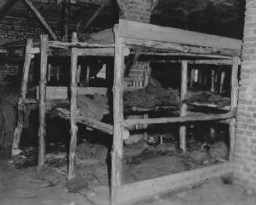
25th Nazi propaganda slide for a Hitler Youth educational presentation in the mid-1930s. The presentation was entitled "5000 years of German Culture." This slide references Lebensraum (the need for living space) in German history: "Wachsende Volkszahl im fargen Nordland zwang neuen Lebensraum zu suchen. Das innerlich morsche Römerreich bricht im Ansturm der Germanen zusammen." Translated as: "Growing numbers of people in Nordland were forced to look for a new habitat. The inwardly…

The daughter of a white German woman and a Black French soldier stands among white classmates, Munich, 1936. This image was included as a slide for lectures on genetics, ethnology, and race breeding at the State Academy for Race and Health in Dresden, Germany.

Distant view of smoke from the Treblinka killing center, set on fire by prisoners during a revolt. This scene was photographed by a railway worker. Treblinka, Poland, August 2, 1943.
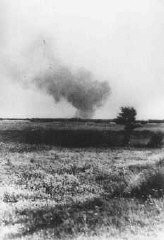
German forces during the military assault on Rotterdam during the Western Campaign. Rotterdam, the Netherlands, May 1940.
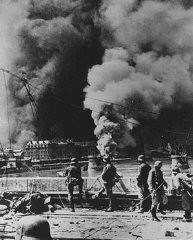
German forces and Polish civilians on the outskirts of Warsaw. In the background of the photograph, the city burns as a result of the German military assault. Warsaw, Poland, September 1939.
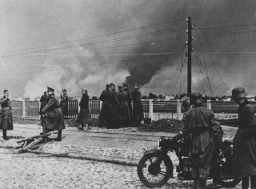
Members of a soccer team in Bitola pose in the goal of a sports field. August 14, 1928.
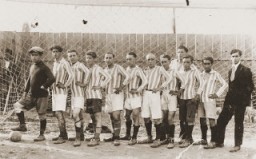
Social Democratic political prisoners in the Duerrgoy concentration camp near Breslau. Seated in the center is Paul Loebe, a leading Socialist and former president of the German parliament. Duerrgoy camp, Germany, August 4, 1933.
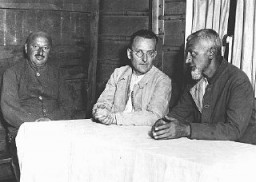
View of Solahütte, an SS retreat near Auschwitz. From Karl Höcker's photograph album, which includes both documentation of official visits and ceremonies at Auschwitz as well as more personal photographs depicting the many social activities that he and other members of the Auschwitz camp staff enjoyed. These rare images show Nazis singing, hunting, and even trimming a Christmas tree. They provide a chilling contrast to the photographs of thousands of Hungarian Jews deported to Auschwitz at the…
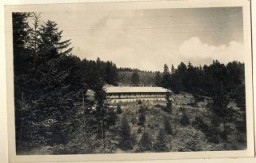
Soldiers of the Polish Home Army (Armia Krajowa) take cover behind a barricade during the Warsaw Polish uprising. During the uprising, the Home Army was supported by 2,500 soldiers from other resistance movements, such as the National Armed Forces (Narodowe Siły Zbrojne, NSZ) and the communist People's Army (Armia Ludowa, AL). Only a quarter of the partisans had access to weapons, fighting against 25,000 German soldiers equipped with artillery, tanks, and air forces. Two of the three soldiers shown here…
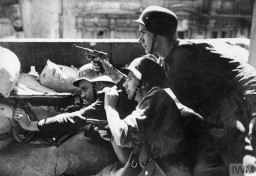
In Poznan, ethnic German recruits to the German army swear allegiance to Adolf Hitler. January 1940.
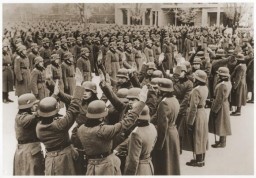
Some of the "Tehran Children," Polish Jewish refugees, study Hebrew in a Jewish National Fund youth village near Jerusalem. Palestine, March 9, 1943.
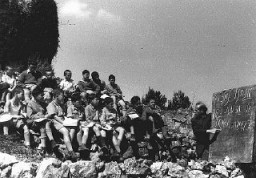
Sophie Ehrhardt, a German hygienist working with Dr. Robert Ritter, performs a racial examination on a Romani woman. Berlin, Germany, c. 1936-1940. During the Nazi era, Dr. Robert Ritter was a leading authority on the racial classification of people pejoratively labeled “Zigeuner” (“Gypsies”). Ritter’s research was in a field called eugenics, or what the Nazis called “racial hygiene.” Ritter worked with a small team of racial hygienists. Among them were Eva Justin and Sophie Ehrhardt. Most…
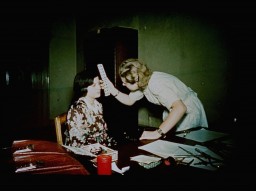
Dr. Sophie Turner-Zaretsky, Space Shuttle Discovery Commander Mark Polansky, and United States Holocaust Memorial Museum chief of staff Bill Parsons. They are holding a replica of "Refugee" bear and a photo of a Darfurian child refugee, items taken by Commander Polansky on a December 2006 Space Shuttle mission.
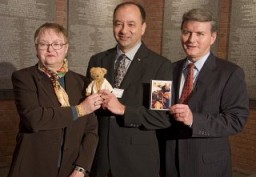
Women and children gather at the door of a soup kitchen maintained by the American Jewish Joint Distribution Committee. The text in Yiddish reads "The fortunate ones with full bowls." Zelechow, Poland, 1940.
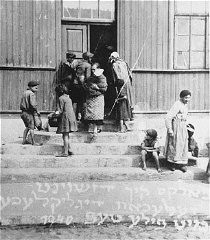
Soviet planes fly over the destroyed Reichstag (German parliament) building in Berlin. Photograph taken by Yevgeny Khaldei. Berlin, Germany, ca. April 1945.
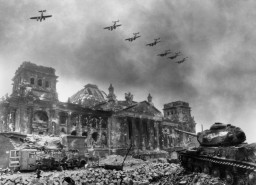
Photograph from a series taken by a guard in the Soviet prisoner-of-war camp of Belzen bei Bergen, and numbered in Roman numerals by the American officer, Lt. van Otten. The camp held approximately 10,000 POWs, most of whom came from Fallingbostel, 10 km away. When they fell ill, they were marched to Belsen. At Belsen, they were starved, often given only a soup made of field beets. This photo shows Soviet POWs assembled at the camp. Germany, 1941–45. Second only to the Jews, Soviet prisoners of war…
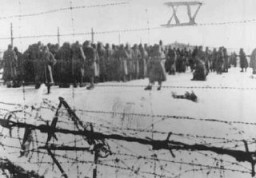
Soviet prisoners of war in the Mauthausen concentration camp. Austria, January 1942.
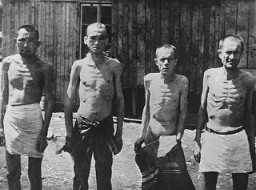
Columns of Soviet prisoners of war. Soviet Union, September 15, 1942. Second only to the Jews, Soviet prisoners of war were the largest group of victims of Nazi racial policy.
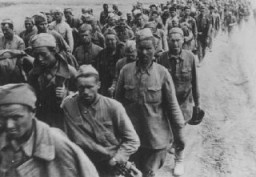
Soviet prisoners of war arrive at the Majdanek camp. Poland, between October 1941 and April 1944.
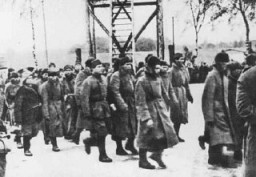
German soldiers force Soviet prisoners of war to construct a rail line. Place uncertain, 1941-1942. This photograph is from an album discovered in a search mission in an abandonend building near Nuremberg by Steven Imburgia while serving with the 633rd Anti-Aircraft Unit.
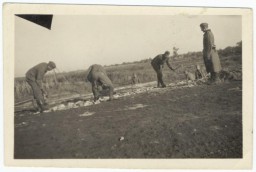
Soviet prisoners of war at forced labor build a road. Probably in the Soviet Union, about 1943.
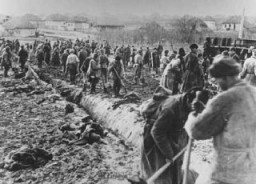
Soviet prisoners of war, survivors of the Majdanek camp, at the camp's liberation. Poland, July 1944. Second only to the Jews, Soviet prisoners of war were the largest group of victims of Nazi racial policy.
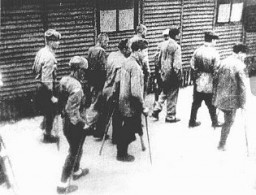
SS officers posing in front of a newly arrived transport of Soviet prisoners of war. Mauthausen concentration camp, Austria, 1941.
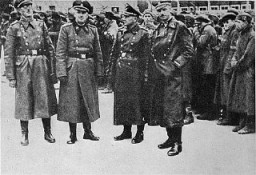
Soviet prisoners of war receiving their meager rations. More than three million Soviet prisoners of war died in German custody, mostly from malnutrition and exposure. Rovno, Poland, 1941. Second only to the Jews, Soviet prisoners of war were the largest group of victims of Nazi racial policy.
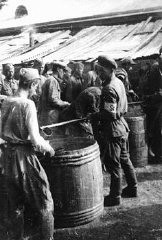
We would like to thank Crown Family Philanthropies, Abe and Ida Cooper Foundation, the Claims Conference, EVZ, and BMF for supporting the ongoing work to create content and resources for the Holocaust Encyclopedia. View the list of donor acknowledgement.